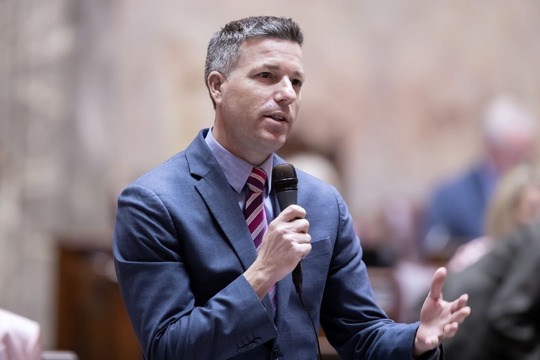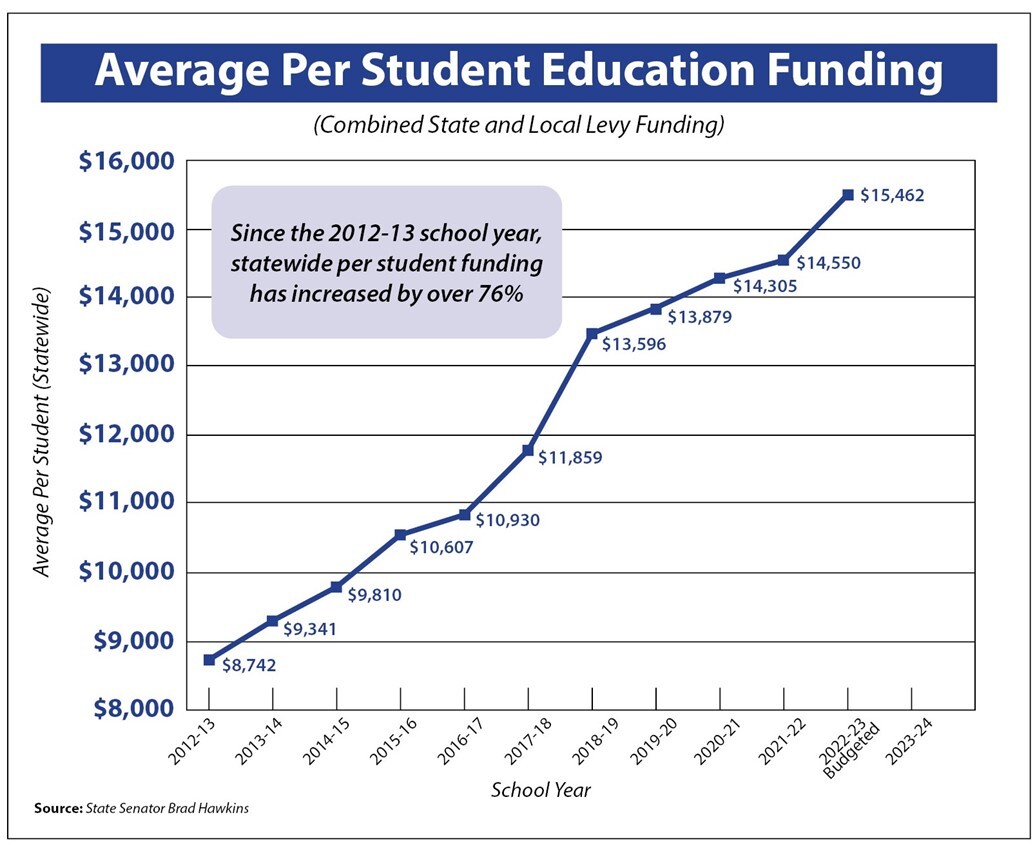|
Jan. 2, 2024
Dear Friends and Neighbors,
As you may know, I serve as the Ranking Member on the Senate’s Early Learning & K-12 Education Committee. Before my election to the Senate, I served on the House Education Committee, and as a school board member for the Eastmont School District and North Central Educational Service District. Also, my wife is a teacher, and I have two kids in public schools.
I am often asked about today’s education system due to my connection to public schools. The Seattle Times editorial board recently highlighted the “confounding” relationship between Washington’s years of increased funding and the “mediocre performance of its public schools.” The Times asked me to submit a guest editorial of my own, expressing my thoughts on this issue. I hope my thoughts help prompt a statewide conversation that I have been encouraging. To read my full editorial, click here.
 Education issues continue to be debated at the State Capitol in Olympia. State dollars and local levy funding have increased significantly, yet schools continue to say they are underfunded.
Are schools taking on too much?
After many years of debate and judicial challenges, our Supreme Court issued its McCleary decision in 2012, which the state eventually satisfied. The fix brought many changes to school funding in Washington. Since then, significant state and local funds have flowed to our schools. During the 2012-13 school year, Washington’s 295 school districts received $8,742 per student in state and local funding. For 2022-23, districts received approximately $15,462 per student. When federal funds are included, districts receive $17,200 per student on average.
Updated figures for the 2023-24 school year will be even more significant, yet students achieving state standards across grade levels is only 50.7% for English and 39.1% for math. Considering recent funding increases, these test scores may initially seem confounding. However, something else is occurring, connecting increased funding to the “mediocre” academics mentioned by The Times.
Statewide school leaders and some legislators have succeeded in strategically and systematically redefining “education” to include everything. This approach not only requires more funding, but also diminishes academics as the top priority for schools. School districts should return to a more reasonable scope of services and enlist the greater help of parents and community providers when children in their schools have non-education needs.
 Debate continues in Olympia about education funding issues following the 2012 State Supreme Court McCleary decision. As the Senate Education Committee’s Ranking Member, I help lead the floor debate on education issues in the Senate. Before being elected to the Legislature, I served for 10 years on school boards and have two children in the public school system.
By pushing preschool into our K-12 system, expanding to all-day meal programs, having schools deliver year-round childcare, raising social and emotional support expectations, and promoting the co-location of healthcare services, it seems the state is trying to transition all societal services into our school system. Such a broad approach must be more operationally realistic and financially sustainable for the school system.
Many needs exist within our school population, but we should consider who can deliver services most efficiently and refer students accordingly. Unfortunately, meeting academic expectations, our schools' once-fundamental responsibility is now being relegated to a lower priority within this much broader system.
We should also speak candidly about graduation rates because this is a statistic many statewide school leaders and school districts like to use. The high school, graduation rate metric, is no longer as helpful as it once was because as the state lowers academics as a priority - by making it just one of many school priorities - students may be “graduating” from our K-12 system without the skills they truly need for their colleges or careers.
Our universities have dedicated significant hours for remedial work to prepare college students for university-level classes. Some of our state’s largest and most successful tech companies have shared with me that they want to hire in-state employees but often have to fill positions with international workers. Those are a lot of career-defining and economic-boosting jobs missed by Washington graduates.
 As taxpayers continue investing more state and local dollars into education, debate continues about whether the state fully funds education. Expanding services for school districts raises costs, adds complexities for staff, and shifts focus from academics. The chart above shows per-student funding in state and local dollars. When federal funding is added, the cost is now $17,200 per student and growing.
Missed opportunities for students
In discussing past efforts to reform education funding, many legislators advocated for changes back when we were negotiating a McCleary solution. Those ideas, if implemented then, likely would have resulted in meaningful improvements now. Many policy suggestions were rejected years later during the pandemic, which included more in-person learning, adding instructional hours to the school year, reforming the school calendar, and using more federal funds for intensive tutoring.
The rejection of these ideas makes the current school struggles even more difficult to accept. As well, during the 2023 legislative session less than a year ago, the state spent $3 billion more on K-12 education primarily to fund the same system – just more generously. These were all missed opportunities for Washington State.
While I strongly support education, we need to question the direction we are going. It is reasonable and responsible to ask whether school districts should be the deliverer of all services, especially if they struggle to fulfill their fundamental responsibility as academic institutions. Frankly, it is becoming increasingly more difficult to differentiate where school responsibilities end and where family and community responsibilities begin. This approach only prompts philosophical debate and encourages more parents to pull their children from public schools, which they have been doing in high numbers.
Despite the significant funding increases taxpayers have supported in recent years, the state will never “fully fund” this expansive social services model for schools. Perhaps that sets up a scenario that some statewide education leaders want, like McCleary, all over again. But rather than spending billions of dollars more each year for the same or lesser results, let’s ask ourselves whether we are on the right track. Our taxpayers, businesses, and communities deserve a statewide conversation about this issue. Now is the time to question our approach and to re-prioritize academics as education’s top priority.
 I greatly appreciate the opportunity to serve as your State Senator. If you have any questions about issues, please contact our Legislative Hotline at 1-800-562-6000 or visit my website at senatorbradhawkins.org.
I recently joined KPQ’s Dave Bernstein to discuss education funding. We discussed my recent editorial published in The Seattle Times and issues related to school construction. The topic of school facilities was recently featured in my November 21, 2023 email newsletter. Both aspects of education funding (operations and construction) have been big topics in the Legislature and are subject to State Supreme Court decisions.
Listen to my full hour Interview on KPQ’s The Agenda (Dec. 15, 2023).
Thank you for the opportunity to serve
It is my honor to serve as your state senator. If you have any questions about education funding or other issues, please call our Legislative Hotline at 1-800-562-6000. To learn more about my legislative efforts on your behalf, please senatorbradhawkins.org.
Also, my office has been actively working to share information about my Facebook page. You can like and follow me on Facebook @SenatorBradHawkins for my latest updates.
Thank you for the opportunity to serve as your state senator.
Sincerely,
 Brad Hawkins
State Senator Brad Hawkins
12th Legislative District
Website: senatorbradhawkins.org
P.O. Box 40412 | Olympia, WA 98504-0412
(360) 786-7622 or Toll-free: (800) 562-6000
|